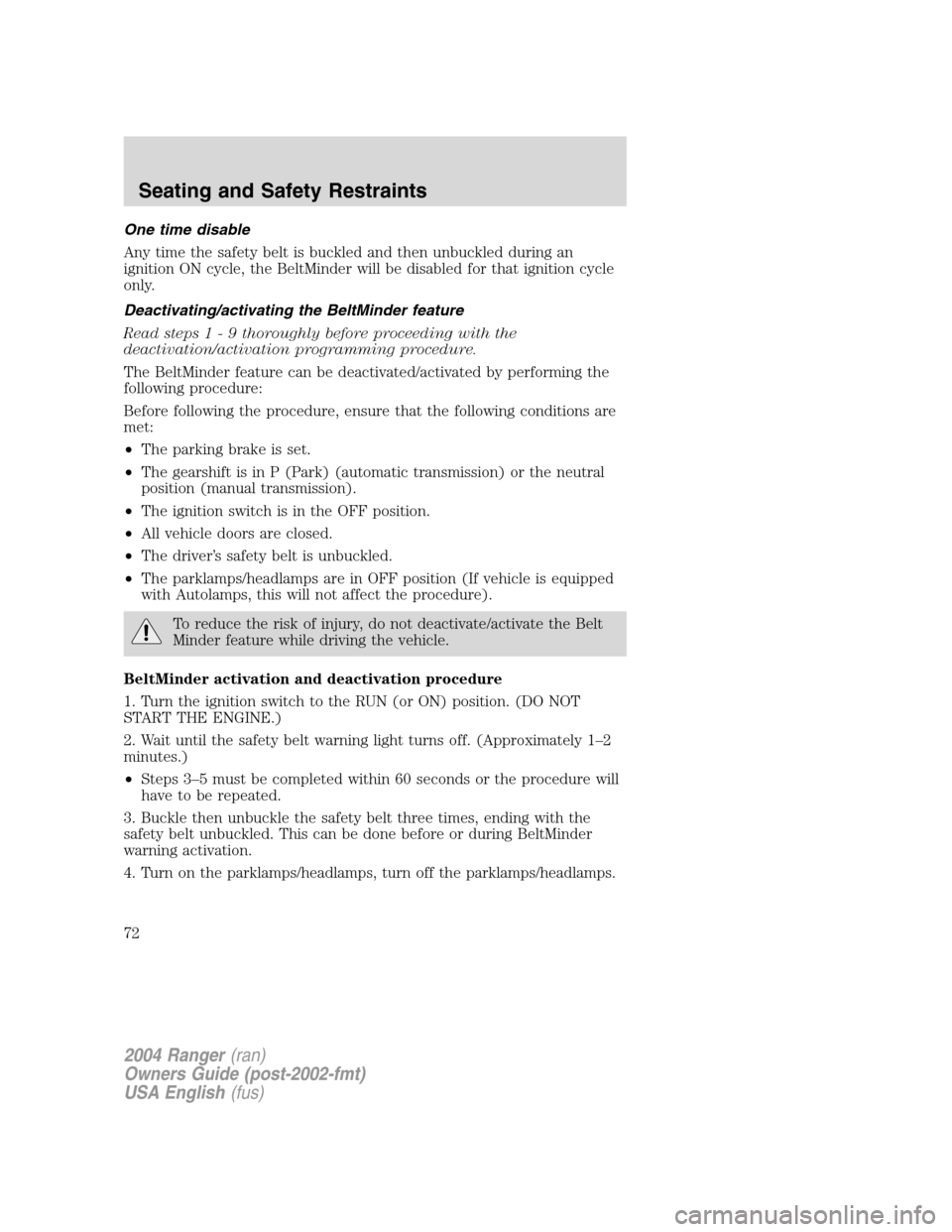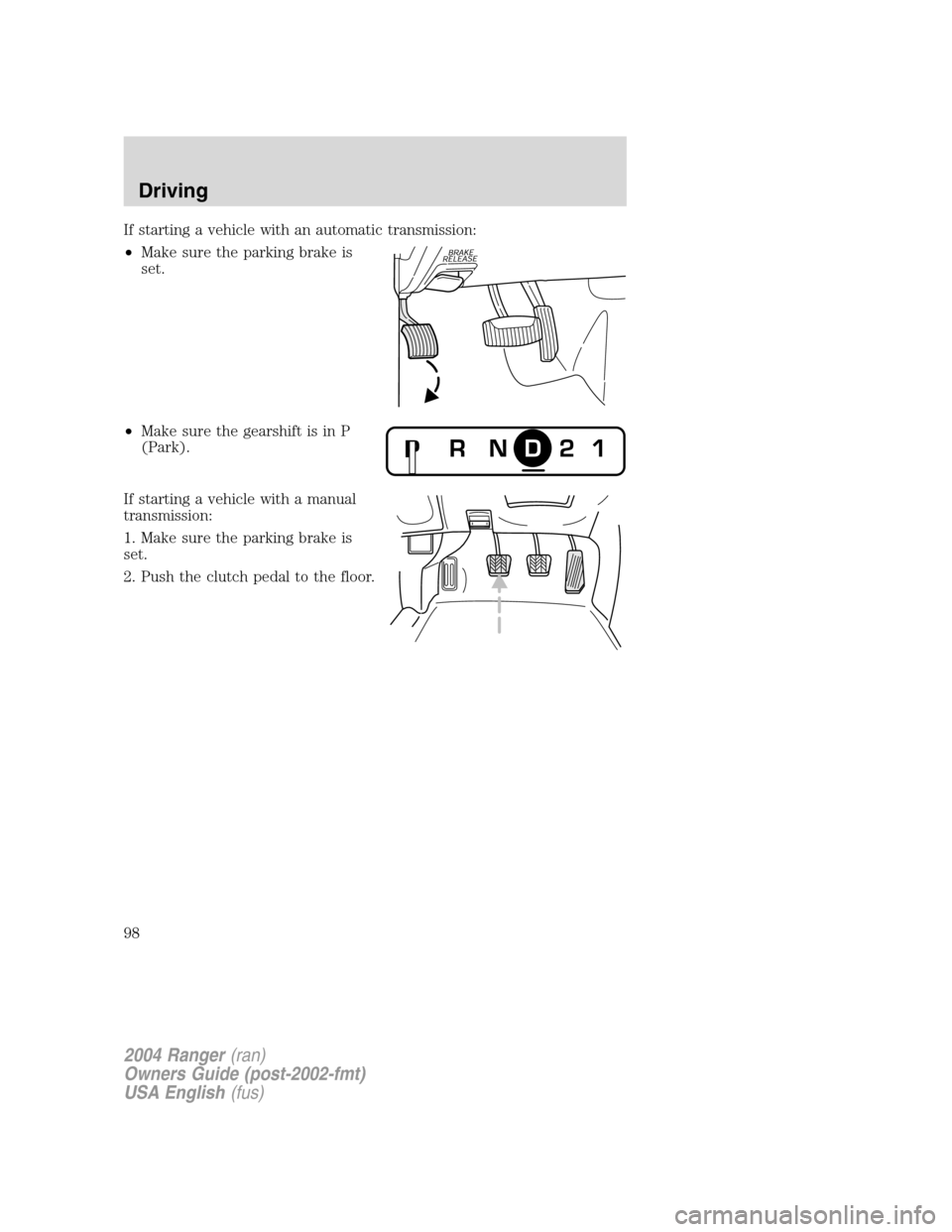2004 FORD RANGER manual transmission
[x] Cancel search: manual transmissionPage 72 of 248

One time disable
Any time the safety belt is buckled and then unbuckled during an
ignition ON cycle, the BeltMinder will be disabled for that ignition cycle
only.
Deactivating/activating the BeltMinder feature
Read steps1-9thoroughly before proceeding with the
deactivation/activation programming procedure.
The BeltMinder feature can be deactivated/activated by performing the
following procedure:
Before following the procedure, ensure that the following conditions are
met:
• The parking brake is set.
• The gearshift is in P (Park) (automatic transmission) or the neutral
position (manual transmission).
• The ignition switch is in the OFF position.
• All vehicle doors are closed.
• The driver ’s safety belt is unbuckled.
• The parklamps/headlamps are in OFF position (If vehicle is equipped
with Autolamps, this will not affect the procedure).
To reduce the risk of injury, do not deactivate/activate the Belt
Minder feature while driving the vehicle.
BeltMinder activation and deactivation procedure
1. Turn the ignition switch to the RUN (or ON) position. (DO NOT
START THE ENGINE.)
2. Wait until the safety belt warning light turns off. (Approximately 1 –2
minutes.)
• Steps 3 –5 must be completed within 60 seconds or the procedure will
have to be repeated.
3. Buckle then unbuckle the safety belt three times, ending with the
safety belt unbuckled. This can be done before or during BeltMinder
warning activation.
4. Turn on the parklamps/headlamps, turn off the parklamps/headlamps.
2004 Ranger (ran)
Owners Guide (post-2002-fmt)
USA English (fus)
Seating and Safety Restraints
72
Page 96 of 248

STARTING
Positions of the ignition
1. ACCESSORY, allows the electrical
accessories such as the radio to
operate while the engine is not
running.
2. LOCK, locks the steering wheel,
automatic transmission gearshift
lever and allows key removal. For
vehicles equipped with a manual
transmission, you must depress the
ignition release lever to release the
key.
3. OFF, shuts off the engine and all accessories without locking the
steering wheel. This position also allows the automatic transmission shift
lever to be moved from the P (Park) position without the brake pedal
being depressed.
When the key is in the ignition and in the OFF position, the
automatic transmission shift lever can be moved from the P
(Park) position without the brake pedal depressed. To avoid unwanted
vehicle movement, always set the parking brake.
4. ON, all electrical circuits operational. Warning lights illuminated. Key
position when driving.
5. START, cranks the engine. Release the key as soon as the engine
starts.
Preparing to start your vehicle
Engine starting is controlled by the powertrain control system. This
system meets all Canadian Interference-Causing Equipment standard
requirements regulating the impulse electrical field strength of radio
noise.
When starting a fuel-injected engine, don ’t press the accelerator before
or during starting. Only use the accelerator when you have difficulty
starting the engine. For more information on starting the vehicle, refer to
Starting the engine in this chapter.
3
1
2
5
4
2004 Ranger(ran)
Owners Guide (post-2002-fmt)
USA English (fus)
Driving
Driving
96
Page 98 of 248

If starting a vehicle with an automatic transmission:
•Make sure the parking brake is
set.
• Make sure the gearshift is in P
(Park).
If starting a vehicle with a manual
transmission:
1. Make sure the parking brake is
set.
2. Push the clutch pedal to the floor.
2004 Ranger (ran)
Owners Guide (post-2002-fmt)
USA English (fus)
Driving
98
Page 102 of 248

The BRAKE warning lamp will
illuminate and will remain
illuminated until the parking brake
is released.
To release, pull the lever (2).
Always set the parking brake fully and make sure that the
gearshift is securely latched in P (Park) (automatic
transmission) or in 1 (First) (manual transmission).
STEERING
To prevent damage to the power steering system:
• Never hold the steering wheel at its furthest turning points (until it
stops) for more than a few seconds when the engine is running.
• Do not operate the vehicle with a low power steering pump fluid level
(below the MIN mark on the reservoir).
If the power steering system breaks down (or if the engine is turned
off), you can steer the vehicle manually, but it takes more effort.
If the steering wanders or pulls, check for:
• an improperly inflated tire
• uneven tire wear
• loose or worn suspension components
• loose or worn steering components
• improper steering alignment
A high crown in the road or high crosswinds may also make the steering
seem to wander/pull.
TRACTION-LOK AXLE (IF EQUIPPED)
This axle provides added traction on slippery surfaces, particularly when
one wheel is on a poor traction surface. Under normal conditions, the
Traction-Lok axle functions like a standard rear axle.
!
BRAKE
2004 Ranger (ran)
Owners Guide (post-2002-fmt)
USA English (fus)
Driving
102
Page 106 of 248

•Use when driving conditions cause excessive shifting from O/D to
other gears. Examples: city traffic, hilly terrain, heavy loads, trailer
towing and when engine braking is required.
• To return to O/D (overdrive mode), press the transmission control
switch. The O/D OFF lamp will not be illuminated.
•
O/D (Overdrive) is automatically returned each time the key is turned off.
2 (Second)
Use 2 (Second) to start-up on slippery roads or to provide additional
engine braking on downgrades.
1 (First)
• Provides maximum engine braking.
• Allows upshifts by moving gearshift lever.
• Will not downshift into 1 (First) at high speeds; allows for 1 (First)
when vehicle reaches slower speeds.
Forced downshifts
• Allowed in
(Overdrive) or Drive.
• Depress the accelerator to the floor.
• Allows transmission to select an appropriate gear.
MANUAL TRANSMISSION OPERATION (IF EQUIPPED)
Using the clutch
The manual transmission has a starter interlock that prevents cranking
the engine unless the clutch pedal is fully depressed.
To start the vehicle:
1. Make sure the parking brake is fully set.
2. Press the clutch pedal to the floor, then put the gearshift lever in the
neutral position.
3. Start the engine, then press the brake pedal and release the parking
brake.
1 35
24 R
2004 Ranger (ran)
Owners Guide (post-2002-fmt)
USA English (fus)
Driving
106
Page 110 of 248

engage while the vehicle is moving; this is normal and should be no
reason for concern. Refer toShifting to/from 4L (4WD Low) for proper
operation.
Shifting between 2WD (2WD High) and 4X4 HIGH (4WD High)
• Move the 4WD control between 2WD and 4X4 HIGH at a stop or any
forward speed up to 88 km/h (55 mph).
Note: Do not perform this operation if the rear wheels are slipping.
Shifting to/from 4X4 LOW (4WD Low)
1. Bring the vehicle to a complete stop
2. Depress the brake
3. On vehicles equipped with an automatic transmission, place the
transmission in N (Neutral); on vehicles equipped with a manual
transmission, depress the clutch.
4. Move the 4WD control to the desired position.
• If shifting into 4WD LOW (4WD Low), wait for the 4WD LOW light in
the instrument cluster to turn onindicating the shift is complete.
• If shifting out of 4WD LOW (4WD Low), wait for the 4WD LOW light
in the instrument cluster to turn offindicating the shift is complete.
Driving off-road with truck and utility vehicles
4WD vehicles are specially equipped for driving on sand, snow, mud and
rough terrain and have operating characteristics that are somewhat
different from conventional vehicles, both on and off the road.
How your vehicle differs from other vehicles
Truck and utility vehicles can differ from some other vehicles. Your
vehicle may be higher to allow it to travel over rough terrain without
getting hung up or damaging underbody components.
The differences that make your vehicle so versatile also make it handle
differently than an ordinary passenger car.
Maintain steering wheel control at all times, especially in rough terrain.
Since sudden changes in terrain can result in abrupt steering wheel
motion, make sure you grip the steering wheel from the outside. Do not
grip the spokes.
Drive cautiously to avoid vehicle damage from concealed objects such as
rocks and stumps.
You should either know the terrain or examine maps of the area before
driving. Map out your route before driving in the area. To maintain
2004 Ranger (ran)
Owners Guide (post-2002-fmt)
USA English (fus)
Driving
110
Page 122 of 248

Towing a trailer places an additional load on your vehicle’s engine,
transmission, axle, brakes, tires and suspension. Inspect these
components carefully after any towing operation.
4x2 w/manual transmission
Engine Rear axle ratio Maximum
GCWR - kg (lbs.) Maximum
trailer weight - kg (lbs.) Maximum
frontal area of trailer - m
2(ft2)
Regular Cab w/6 ’box
2.3L All 2177 (4800) 717 (1580) Equal to frontal areaof vehicle
3.0L All 2722 (6000) 1207 (2660) 4.64 (50)
3.0L Edge All 2722 (6000) 1143 (2520) 4.64 (50) Regular Cab w/7’box
2.3L All 2177 (4800) 689 (1520) Equal to frontal areaof vehicle
3.0L All 2722 (6000) 1170 (2580) 4.64 (50) SuperCab
2.3L All 2177 (4800) 644 (1420) Equal to frontal areaof vehicle
3.0L All 2722 (6000) 1125 (2480) 4.64 (50)
3.0L Edge All 2722 (6000) 1061 (2400) 4.64 (50) 4.0L All 3175 (7000) 1542 (3400) 4.64 (50)
4.0L Edge All 3175 (7000) 1506 (3320) 4.64 (50)
For high altitude operation, reduce GCW by 2% per 300 meters (1000 ft.)
elevation.
For definition of terms used in this table see Vehicle Loadingearlier in
this chapter.
To determine maximum trailer weight designed for your particular vehicle,
see Calculating the load your vehicle can carry/tow earlier in this
chapter.
Maximum trailer weight is shown. The combined weight of the completed
towing vehicle (including hitch, passengers and cargo) and the loaded
trailer must not exceed the Gross Combined Weight Rating (GCWR).
2004 Ranger (ran)
Owners Guide (post-2002-fmt)
USA English (fus)
Driving
122
Page 123 of 248

4x4 w/manual transmission
Engine Rear axle ratioMaximum
GCWR - kg (lbs.) Maximum
trailer
weight - kg (lbs) Maximum
frontal area of trailer - m
2(ft2)
Regular Cab w/6 ’box
3.0L All 2722 (6000) 1061 (2340) 4.64 (50)
4.0L All 3175 (7000) 1479 (3260) 4.64 (50) Regular Cab w/7’box
3.0L All 2722 (6000) 1034 (2280) 4.64 (50)
4.0L All 3175 (7000) 1451 (3200) 4.64 (50) SuperCab
4.0L
(without FX4
package) All 3175 (7000) 1406 (3100) 4.64 (50)
4.0L (with FX4
package) All 3175 (7000) 1243 (2740) 4.64 (50)
For high altitude operation, reduce GCW by 2% per 300 meters (1000 ft.)
of elevation.
For definition of terms used in this table, see Vehicle loadingearlier in
this chapter.
To determine maximum trailer weight designed for your vehicle, see
Calculating the load your vehicle can carry/tow earlier in this chapter.
Maximum trailer weight is shown. The combined weight of the completed
towing vehicle (including hitch, passengers and cargo) and the loaded
trailer must not exceed the Gross Combined Weight Rating (GCWR).
2004 Ranger (ran)
Owners Guide (post-2002-fmt)
USA English (fus)
Driving
123